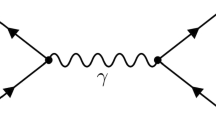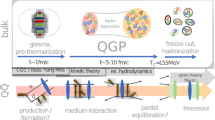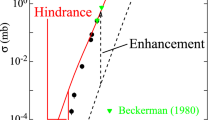Abstract
A novel approach to solve the Faddeev equation for three-body scattering at arbitrary energies is proposed. This approach disentangles the complicated singularity structure of the free three-nucleon propagator leading to the moving and logarithmic singularities in standard treatments. The Faddeev equation is formulated in momentum space and directly solved in terms of momentum vectors without employing a partial wave decomposition. In its simplest form the Faddeev equation for identical bosons, which we are using, is an integral equation in five variables, magnitudes of relative momenta and angles. The singularities of the free propagator and the deuteron propagator are now both simple poles in two different momentum variables, and thus can both be integrated with standard techniques.
Similar content being viewed by others
References
Faddeev L.D.: Sov. Phys. JETP 12, 1014 (1961)
Faddeev L.D.: Mathematical Aspects of the Three Body Problem in Quantum Scattering Theory. D. Darey, London (1965)
Faddeev L.D., Merkuriev S.P.: Quantum Scattering Theory for Several Particle Systems. Kluwer, Dordrecht (1993)
Mitra A.N.: Three-body problem with separable potentials (I) bound states. Nucl. Phys. 32, 529 (1962)
Lovelace C.: Practical theory of three-particle states. I. Nonrelativistic. Phys. Rev. 135, 1125 (1964)
Schmied E.W., Ziegelmann H.: The Quantum Mechanical Three-Body Problem. Vieweg Tracts in Pure and Applied Physics, vol. 2. Pergamon, Oxford (1974)
Redish, E.F.: Lectures in the Quantum Three-Body Problem, Lecture Series in Theoretical Nuclear Physics, University of Maryland, Tr 77-060 (1976)
Glöckle W.: The Quantum Mechanical Few-Body Problem. Springer, Berlin (1983)
Hetherington J.H., Schick L.H.: Exact multiple-scattering analysis of low-energy elastic K–d scattering with separable potentials. Phys. Rev. 137, 935 (1965)
Cahill R.T., Sloan I.H.: Theory of neutron–deuteron breakup. Nucl. Phys. A 165, 161 (1971)
Kloet W.M., Tjon J.A.: A study of break up processes in neutron–deuteron scattering. Nucl. Phys. A 210, 380 (1973)
Witała H., Cornelius T., Glöckle W.: Elastic scattering and break-up processes in the n–d system. Few-body Systems 3, 123 (1988)
Witała H., Glöckle W., Cornelius T.: Nucleon-induced deuteron breakup: analysis of 14.1 MeV data by rigorous Faddeev calculations with meson-exchange NN interactions. Phys. Rev. C 39, 384 (1989)
Glöckle W. et al.: The three-nucleon continuum: achievements, challenges, and applications. Phys. Rep. 274, 107 (1996)
Glöckle, W.: In: Pike, R., Sabatier, P. (eds.) Scattering, Scattering and Inverse Scattering in Pure and Applied Science, pp. 1339–1359. Academic Press, New York (2002)
Witala H., Glöckle W., Cornelius T.: Nucleon-induced deuteron breakup: analysis of 14.1 MeV data by rigorous Faddeev calculations with meson-exchange NN interactions. Phys. Rev. C 63, 024007 (2001)
Epelbaum E. et al.: Three-nucleon forces from chiral effective field theory. Phys. Rev. C 66, 064001 (2002)
Deltuva A., Fonseca A.C., Sauer P.U.: Momentum-space description of three-nucleon breakup reactions including the Coulomb interaction. Phys. Rev. C 72, 054004 (2005)
Liu H., Elster Ch., Glöckle W.: Three-body scattering at intermediate energies. Phys. Rev. C 72, 054003 (2005)
Elster Ch., Lin T., Glöckle W., Jeschonnek S.: Faddeev and Glauber calculations at intermediate energies in a model for n+d scattering. Phys. Rev. C 78, 034002 (2008)
Lin T., Elster Ch., Polyzou W.N., Glöckle W.: Relativistic effects in exclusive PD breakup scattering at intermediate energies. Phys. Lett. B 660, 345 (2008)
Lin, T., Elster, Ch., Polyzou, W.N., Glöckle, W.: Poincaré invariant three-body scattering at intermediate energies. arXiv:0801.3210 [nucl-th]
Witala, H., Glöckle, W.N.: A new form of three-body Faddeev equations in the continuum. arXiv:0806.2757 [nucl-th]
Alt E.O., Grassberger P., Sandhas W.: Reduction of the three-particle collision problem to multichannel two-particle Lippmann–Schwinger equations. Nucl. Phys. B 2, 167 (1967)
Author information
Authors and Affiliations
Corresponding author
Rights and permissions
About this article
Cite this article
Elster, C., Glöckle, W. & Witała, H. A New Approach to the 3D Faddeev Equation for Three-body Scattering. Few-Body Syst 45, 1–10 (2009). https://doi.org/10.1007/s00601-008-0003-6
Received:
Accepted:
Published:
Issue Date:
DOI: https://doi.org/10.1007/s00601-008-0003-6




